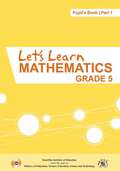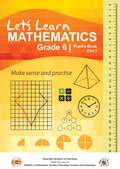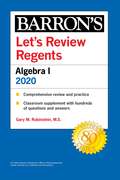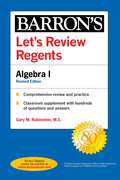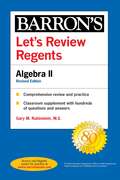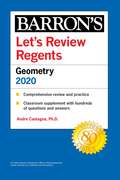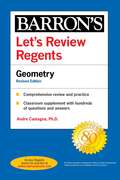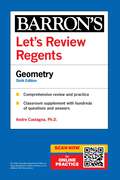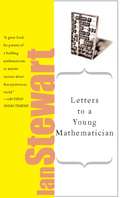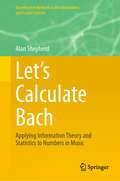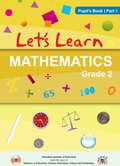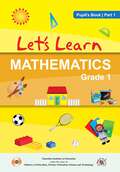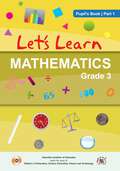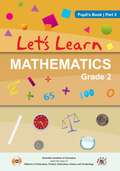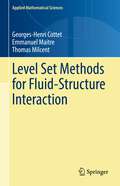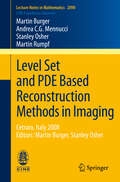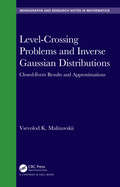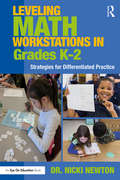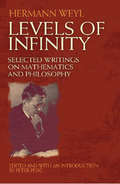- Table View
- List View
Let's Learn Mathematics Part-1 - Pupil's Book class 5 - MIE
by Mauritius Institute of EducationThe "MATHEMATICS Grade 5 Pupil’s Book Part 1" is a comprehensive textbook crafted by a panel of mathematics experts from the Mauritius Institute of Education and the Ministry of Education and Human Resources, Tertiary Education and Scientific Research. Designed for Grade 5 students in Mauritius, the book covers essential aspects of the mathematics curriculum, including numeration, notation, geometry, fractions, and powers. With a vibrant and visually appealing layout, the book features clear learning objectives, engaging activities, illustrative examples, and diverse exercises for practice. Aligned with the national curriculum framework, it incorporates continuous assessments to gauge understanding. The book employs a friendly tone to inspire students, providing encouragement, tips, and hints, and includes questions, puzzles, and games to foster curiosity. Intended for students, teachers, and parents, this resource aims to cultivate mathematical proficiency, skills, confidence, appreciation, and interest in young learners.
Let's Learn Mathematics Part-1 - Pupil's Book class 6 - MIE
by Mauritius Institute of EducationGrade 6 part 1 mathematics textbook follows the National Curriculum Framework, encompassing units on shapes, numeration, fractions, decimals, and problem-solving techniques. The curriculum introduces students to 2-D and 3-D shapes, emphasizing properties, classification, and drawing techniques. Numeration and place value cover reading and writing large numbers, using tools like arrays and abacus. The text explores division with remainders, methods for comparing quantities, and the concepts of fractions and decimals, detailing addition, subtraction, multiplication, and division operations. Problem-solving strategies like thinking blocks and drawing diagrams are introduced with examples spanning various real-world scenarios. The book includes continuous assessments and challenging problems across multiple mathematical domains, fostering problem-solving skills. Motivational quotes from mathematicians and scientists aim to inspire students, while thorough references provide additional resources. Answers are provided with explanations, utilizing LaTeX for mathematical expressions. This comprehensive textbook aims to engage and empower Grade 6 pupils in their mathematical learning journey.
Let's Learn Mathematics Part-2 - Pupil's Book class 4 - MIE
by Mauritius Institute of EducationThe grade 4 mathematics textbook, part 2 of a series, delves into fundamental mathematical concepts with a focus on practical applications for fourth-grade pupils. Covering lines, angles, 2-D and 3-D shapes, time, length, capacity, mass, and graphs, the curriculum emphasizes hands-on learning. Students learn to draw and compare lines, create and measure angles using an angle maker, and explore the properties of 2-D and 3-D shapes. The textbook introduces time-telling skills using analog and digital clocks, and addresses the measurement of length, capacity, and mass with real-world examples. Additionally, it provides a foundation for data interpretation through the representation and analysis of graphs using pictograms and bar charts. This comprehensive approach aims to foster a holistic understanding of mathematical principles while promoting practical problem-solving skills.
Let's Learn Mathematics Part-2 - Pupil's Book class 5 - MIE
by Mauritius Institute of EducationThis grade 5 mathematics textbook comprises four comprehensive units designed to enhance pupils' mathematical proficiency. Unit 1, "Numbers," delves into concepts such as average, direct proportion, ratio, and fractions, offering clear definitions, examples, and engaging activities. Unit 2, "Measure," explores diverse measurement topics, including length, perimeter, area, capacity, mass, money, and time, emphasizing practical applications through exercises and word problems. Unit 3, "Graphs," focuses on pictograms and bar charts, guiding pupils in interpreting and utilizing graphs for data representation. The final unit, "Continuous Assessment," evaluates students through multiple-choice and short-answer questions, ensuring a thorough understanding of the material. Throughout the textbook, each unit features valuable tips and hints to facilitate comprehension and practical application of mathematical principles.
Let's Learn Mathematics Part-2 - Pupil's Book class 6 - MIE
by Mauritius Institute of EducationThe textbook, "MATHEMATICS Grade 6 Pupil’s Book Part 2," authored by Professor Vassen NAËCK and a team of mathematics experts from the Mauritius Institute of Education and the Ministry of Education, serves as a comprehensive guide for sixth-grade students. Covering essential mathematical concepts, it spans topics such as numbers, measure, geometry, charts, and problem-solving. Highlighting key units, the textbook explores Patterns and Sequences (Unit 16), Powers (Unit 17), and Time - Calendar (Unit 18). These units provide in-depth explanations, examples, and exercises, offering students a thorough understanding of mathematical principles. The textbook's well-structured content, consisting of units with diverse subtopics, ensures a comprehensive approach to sixth-grade mathematics education. Furthermore, the appendices provide practical templates for constructing 3-D cubes and cuboids, enhancing the hands-on learning experience. Overall, the textbook serves as a valuable resource, fostering a holistic and engaging learning environment for students.
Let's Review Regents: Algebra I 2020 (Barron's Regents NY)
by Gary M. RubinsteinBarron's Let's Review Regents: Algebra I 2020 gives students the step-by-step review and practice they need to prepare for the Regents exam. This updated edition is an ideal companion to high school textbooks and covers all Algebra I topics prescribed by the New York State Board of Regents. Features include: * In-depth Regents exam preparation, including two recent Algebra I Regents exams and answer keys * Easy to read topic summaries * Step-by-step demonstrations and examples * Review of all Algebra I topics * Hundreds of sample questions with fully explained answers for practice and review, and more Teachers can also use this book to plan lessons and as a helpful resource for practice, homework, and test questions. Looking for additional review? Check out Barron’s Regents Algebra I Power Pack 2020 two-volume set, which includes Regents Exams and Answers: Algebra I 2020 in addition to Let’s Review Regents: Algebra I 2020.
Let's Review Regents: Algebra I Revised Edition (Barron's Regents NY)
by Gary M. RubinsteinBarron's Let's Review Regents: Algebra I 2020 gives students the step-by-step review and practice they need to prepare for the Regents exam. This updated edition is an ideal companion to high school textbooks and covers all Algebra I topics prescribed by the New York State Board of Regents. All Regents test dates for 2020 have been canceled. Currently the State Education Department of New York has released tentative test dates for the 2021 Regents. The dates are set for January 26-29, 2021, June 15-25, 2021, and August 12-13th. Features include:In-depth Regents exam preparation, including two recent Algebra I Regents exams and answer keysEasy to read topic summariesStep-by-step demonstrations and examplesReview of all Algebra I topicsHundreds of sample questions with fully explained answers for practice and review, and moreTeachers can also use this book to plan lessons and as a helpful resource for practice, homework, and test questions.Looking for additional review? Check out Barron&’s Regents Algebra I Power Pack 2020 two-volume set, which includes Regents Exams and Answers: Algebra I 2020 in addition to Let&’s Review Regents: Algebra I 2020.
Let's Review Regents: Algebra II Revised Edition (Barron's Regents NY)
by Gary M. Rubenstein M.S.Barron's Let's Review Regents: Algebra II 2020 gives students the step-by-step review and practice they need to prepare for the Regents exam. This updated edition is an ideal companion to high school textbooks and covers all Algebra II topics prescribed by the New York State Board of Regents. All Regents test dates for 2020 have been canceled. Currently the State Education Department of New York has released tentative test dates for the 2021 Regents. The dates are set for January 26-29, 2021, June 15-25, 2021, and August 12-13th. Features include:In-depth Regents exam preparation, including two recent Algebra II Regents exams and answer keysEasy to read topic summariesStep-by-step demonstrations and examplesHundreds of sample questions with fully explained answers for practice and review, and moreReview of all Algebra II topics, including Polynomial Functions, Exponents and Equations, Transformation of Functions, Trigonometric Functions and their Graphs, Using Sine and Cosine, and much moreTeachers can also use this book to plan lessons and as a helpful resource for practice, homework, and test questions.Looking for additional practice and review? Check out Barron&’s Algebra II Power Pack 2020 two-volume set, which includes Regents Exams and Answers: Algebra II 2020 in addition to Let&’s Review Regents: Algebra II 2020.
Let's Review Regents: Geometry 2020 (Barron's Regents)
by Andre CastagnaBarron's Let's Review Regents: Geometry 2020 gives students the step-by-step review and practice they need to prepare for the Regents exam. This updated edition is an ideal companion to high school textbooks and covers all Geometry topics prescribed by the New York State Board of Regents.This edition includes: Two actual Regents exams in Geometry, plus answer keys for each test. Review and practice problems for all topics on the exam, including the language of geometry, basic geometric relationships (parallel lines, polygons, and triangle relationships), constructions, an introduction to geometric proof transformations, triangle congruence, similarity and right triangle trigonometry, parallelograms, circles and arcs, coordinate geometry and proofs on the coordinate plane, and volume (modeling 3-D shapes in practice applications) Looking for additional review? Check out Barron’s Regents Geometry Power Pack 2020 two-volume set, which includes Regents Exams and Answers: Geometry 2020 in addition to Let’s Review Regents: Geometry 2020.
Let's Review Regents: Geometry Revised Edition (Barron's Regents NY)
by Andre Castagna Ph.D.Barron's Let's Review Regents: Geometry 2020 gives students the step-by-step review and practice they need to prepare for the Regents exam. This updated edition is an ideal companion to high school textbooks and covers all Geometry topics prescribed by the New York State Board of Regents.All Regents test dates for 2020 have been canceled. Currently the State Education Department of New York has released tentative test dates for the 2021 Regents. The dates are set for January 26-29, 2021, June 15-25, 2021, and August 12-13th. This edition includes:Two actual Regents exams in Geometry, plus answer keys for each testReview and practice problems for all topics on the exam, including the language of geometry, basic geometric relationships (parallel lines, polygons, and triangle relationships), constructions, an introduction to geometric proof transformations, triangle congruence, similarity and right triangle trigonometry, parallelograms, circles and arcs, coordinate geometry and proofs on the coordinate plane, and volume (modeling 3-D shapes in practice applications)Looking for additional review? Check out Barron&’s Regents Geometry Power Pack 2020 two-volume set, which includes Regents Exams and Answers: Geometry 2020 in addition to Let&’s Review Regents: Geometry 2020.
Let's Review Regents: Geometry, Sixth Edition (Barron's New York Regents)
by Barron's Educational Series Andre, Ph.D. Castagna Ph.D.Barron's Let's Review Regents: Geometry gives students the step-by-step review and practice they need to prepare for the Regents exam. This updated edition is an ideal companion to high school textbooks and covers all Geometry topics prescribed by the New York State Board of Regents. Features include: In-depth Regents exam preparation, including one recent Geometry Regents exam and a sample of the revised test for the changes being made for 2025, both with full answer keys Review of all Geometry topics as per the revised course and exam for 2025 Easy to read topic summaries Revised step-by-step demonstrations and examples Hundreds of questions with fully explained answers for extra practice and review, and more Publisher's Note: Products purchased from 3rd party sellers are not guaranteed by the publisher for quality, authenticity, or access to any online entities included with the product.
Letters to a Young Mathematician
by Ian StewartThe first scientific entry in the acclaimed Art of Mentoring series from Basic Books,Letters to a Young Mathematiciantells readers what Ian Stewart wishes he had known when he was a student and young faculty member. Subjects ranging from the philosophical to the practical--what mathematics is and why it's worth doing, the relationship between logic and proof, the role of beauty in mathematical thinking, the future of mathematics, how to deal with the peculiarities of the mathematical community, and many others--are dealt with in Stewart's much-admired style, which combines subtle, easygoing humor with a talent for cutting to the heart of the matter. In the tradition of G. H. Hardy's classicA Mathematician's Apology, this book is sure to be a perennial favorite with students at all levels, as well as with other readers who are curious about the frequently incomprehensible world of mathematics.
Let’s Calculate Bach: Applying Information Theory and Statistics to Numbers in Music (Quantitative Methods in the Humanities and Social Sciences)
by Alan ShepherdThis book shows how information theory, probability, statistics, mathematics and personal computers can be applied to the exploration of numbers and proportions in music. It brings the methods of scientific and quantitative thinking to questions like: What are the ways of encoding a message in music and how can we be sure of the correct decoding? How do claims of names hidden in the notes of a score stand up to scientific analysis? How many ways are there of obtaining proportions and are they due to chance?After thoroughly exploring the ways of encoding information in music, the ambiguities of numerical alphabets and the words to be found “hidden” in a score, the book presents a novel way of exploring the proportions in a composition with a purpose-built computer program and gives example results from the application of the techniques. These include information theory, combinatorics, probability, hypothesis testing, Monte Carlo simulation and Bayesian networks, presented in an easily understandable form including their development from ancient history through the life and times of J. S. Bach, making connections between science, philosophy, art, architecture, particle physics, calculating machines and artificial intelligence. For the practitioner the book points out the pitfalls of various psychological fallacies and biases and includes succinct points of guidance for anyone involved in this type of research.This book will be useful to anyone who intends to use a scientific approach to the humanities, particularly music, and will appeal to anyone who is interested in the intersection between the arts and science.With a foreword by Ruth Tatlow (Uppsala University), award winning author of Bach’s Numbers: Compositional Proportion and Significance and Bach and the Riddle of the Number Alphabet.“With this study Alan Shepherd opens a much-needed examination of the wide range of mathematical claims that have been made about J. S. Bach's music, offering both tools and methodological cautions with the potential to help clarify old problems.” Daniel R. Melamed, Professor of Music in Musicology, Indiana University
Let’s Learn Mathematics Part-1 - Pupil's Book class 2 - MIE
by Mauritius Institute of EducationThe Grade 2 Mathematics Workbook and Teacher’s Book align with the philosophical principles of the New Curriculum Framework (Primary) and extend the pedagogical approaches from Grade 1. Designed to facilitate a smooth transition, the materials aim to enhance pupils' understanding and enjoyment of key mathematical concepts. Concepts are introduced sequentially through engaging stories, connecting them to real-life contexts, with an emphasis on interdisciplinary links, life skills, and ICT integration. Child-friendly presentation and progressive activities aid comprehension, while continuous assessment and profiling support educators in monitoring pupil progress. The role of educators as facilitators is underscored, encouraging them to leverage the 'Note to Teacher' for effective conceptual understanding. The Mathematics Panel anticipates that these curriculum materials will instill enjoyment and foster a deeper interest in the study of Mathematics among pupils.
Let’s Learn Mathematics Part-1 - Pupil’s Book class 1 - MIE
by Mauritius Institute of EducationThe Mathematics Pupil’s Book Part 1 for Grade 1 offers a comprehensive foundation for young learners in fundamental mathematical concepts aligned with the National Curriculum Framework. Structured around three engaging themes - Home, School, and Games - the textbook incorporates a variety of activities, such as drawing, tracing, writing, coloring, matching, sorting, and comparing objects and numbers. These activities are designed to be interactive and enjoyable, fostering a child-friendly learning environment. Clear learning objectives and outcomes are outlined for each theme and unit, accompanied by continuous assessment and profiling exercises to gauge student progress. The textbook also features an annex with a memory game to reinforce recognition of shapes, colors, and numbers. Overall, it provides a well-rounded and interactive approach to cultivating essential mathematical skills in Grade 1 students.
Let’s Learn Mathematics Part-1 - Pupil’s Book class 3 - MIE
by Mauritius Institute of EducationThe Grade 3 Mathematics Pupil’s Book Part 1 offers a comprehensive exploration of key mathematical concepts essential for third-grade students. It covers Geometry, introducing shapes, sides, vertices, patterns, tessellation, and activities integrating ICT tools like Ms Paint. Additionally, it delves into Graphs, teaching how to understand and create pictograms, count shapes, and interpret data using ICT tools. The book also focuses on Numbers, from 0 to 1000, emphasizing place value, number sequences, and exercises involving the abacus and number lines. Furthermore, it addresses Addition techniques, including adding numbers with and without carrying, solving word problems, and utilizing ICT for practice. Mass concepts, such as comparing weights and practical activities to grasp kilograms, are also covered. Emphasizing technology in learning, the book incorporates continuous assessment and profiling sections to monitor student progress effectively.
Let’s Learn Mathematics Part-2 - Pupil's Book class 2 - MIE
by Mauritius Institute of EducationThe Mathematics Grade 6 Pupil’s Book Part 2, designed for students in Mauritius, is a comprehensive textbook developed by the Mauritius Institute of Education and the Ministry of Education and Human Resources. The textbook comprises of units covering diverse mathematical topics like patterns, sequences, powers, time, area, percentages, averages, ratio, proportion, angles, charts, coordinates, line graphs, volume, speed, and problem-solving. Each unit begins with clear learning objectives and concludes with activities to assess students' understanding and skills. The content is reinforced with examples, diagrams, tables, and pictograms to illustrate concepts and methods. Additionally, appendices at the end provide valuable templates for creating 3-D cubes and cuboids, along with examples of shapes and their names. This well-structured textbook aims to enhance students' mathematical proficiency through engaging content and practical exercises.
Let’s Learn Mathematics Part-2 - Pupil’s Book class 1 - MIE
by Mauritius Institute of EducationThe Mathematics Pupil’s Book Part 2 for Grade 1 is a comprehensive resource designed to cultivate fundamental mathematical concepts and skills in young learners. Covering areas such as numbers, shapes, addition, ordinal numbers, length, mass, time, and money, the textbook engages students with thematic units like "Food," "Transport," and "Animals." Each unit creatively integrates mathematical principles with real-world examples, such as fruits and vegetables, vehicles, and animals, making the learning experience relatable and enjoyable. In addition to these thematic units, the textbook provides valuable sections including Learning Objectives, Acknowledgements, Table of Contents, Profiling, and IT Pack, offering insights into the textbook's aims, authors, structure, assessment, and online resources. This holistic approach ensures a well-rounded learning experience, fostering the development of essential mathematical skills in Grade 1 students.
Let’s Learn Mathematics Part-2 - Pupil’s Book class 3 - MIE
by Mauritius Institute of EducationThe Grade 3 Mathematics Pupil’s Book Part 2 delves into fundamental concepts such as capacity, ordinal numbers, Roman numerals, multiplication, and more. Designed to enhance arithmetic skills and mental calculations, it also focuses on fractions and measurement. Through engaging activities, students explore concepts like measuring length, solving word problems, and grasping the significance of units. With clear learning objectives centered around arithmetic operations and practical application, this book aims to foster a comprehensive understanding of mathematical concepts essential for the Grade 3 curriculum.
Level Set Methods for Fluid-Structure Interaction (Applied Mathematical Sciences #210)
by Georges-Henri Cottet Emmanuel Maitre Thomas MilcentThis monograph is devoted to Eulerian models for fluid-structure interaction by applying the original point of view of level set methods.In the last 15 years, Eulerian models have become popular tools for studying fluid-structure interaction problems. One major advantage compared to more conventional methods such as ALE methods is that they allow the use of a single grid and a single discretization method for the different media. Level set methods in addition provide a general framework to follow the fluid-solid interfaces, to represent the elastic stresses of solids, and to model the contact forces between solids.This book offers a combination of mathematical modeling, aspects of numerical analysis, elementary codes and numerical illustrations, providing the reader with insights into the applications and performance of these models.Assuming background at the level of a Master’s degree, Level Set Methods for Fluid-Structure Interaction provides researchers in the fields of numerical analysis of PDEs, theoretical and computational mechanics with a basic reference on the topic. Its pedagogical style and organization make it particularly suitable for graduate students and young researchers.
Level Set and PDE Based Reconstruction Methods in Imaging
by Martin Burger Andrea C. G. Mennucci Stanley Osher Martin RumpfThis book takes readers on a tour through modern methods in image analysis and reconstruction based on level set and PDE techniques, the major focus being on morphological and geometric structures in images. The aspects covered include edge-sharpening image reconstruction and denoising, segmentation and shape analysis in images, and image matching. For each, the lecture notes provide insights into the basic analysis of modern variational and PDE-based techniques, as well as computational aspects and applications.
Level-Crossing Problems and Inverse Gaussian Distributions: Closed-Form Results and Approximations (Chapman & Hall/CRC Monographs and Research Notes in Mathematics)
by Vsevolod K. MalinovskiiLevel-Crossing Problems and Inverse Gaussian Distributions: Closed-Form Results and Approximations focusses on the inverse Gaussian approximation for the distribution of the first level-crossing time in a shifted compound renewal process framework. This approximation, whose name was coined by the author, is a successful competitor of the normal (or Cramér's), diffusion, and Teugels’ approximations, being a breakthrough in its conditions and accuracy. Since such approximations underlie numerous applications in risk theory, queueing theory, reliability theory, and mathematical theory of dams and inventories, this book is of interest not only to professional mathematicians, but also to physicists, engineers, and economists. People from industry with a theoretical background in level-crossing problems, e.g., from the insurance industry, can also benefit from reading this book. Features: Primarily aimed at researchers and postgraduates, but may be of interest to some professionals working in related fields, such as the insurance industry Suitable for advanced courses in Applied Probability and, as a supplementary reading, for basic courses in Applied Probability
Leveling Math Workstations in Grades K–2: Strategies for Differentiated Practice
by Nicki NewtonIn this book from bestselling author Dr. Nicki Newton, you’ll learn how to level math workstations to engage K–2 students in meaningful, purposeful, rigorous practice. We know students don’t learn at the same pace, so how do we take into account where they are and differentiate instruction? Dr. Nicki has the answers, showing how leveled workstations are key in the formative years, how they help students operate in their zone of proximal development and how we can use them to help students progress to higher levels of math achievement. Topics include: Understanding the framework for leveled workstations Making sure workstations are rigorous and not just providing busy work Building your stations in key areas such as counting, numbers, place value, fluency and word problems Keeping students accountable, and knowing where they are in their learning trajectory Each chapter offers specific examples, activities and tools. There is also a clear, step-by-step action plan to help you implement the ideas immediately in your own classroom.
Levels of Infinity: Selected Writings on Mathematics and Philosophy (Dover Books on Mathematics)
by Hermann Weyl Peter PesicThis original anthology collects 10 of Weyl's less-technical writings that address the broader scope and implications of mathematics. Most have been long unavailable or not previously published in book form. Subjects include logic, topology, abstract algebra, relativity theory, and reflections on the work of Weyl's mentor, David Hilbert. 2012 edition.
